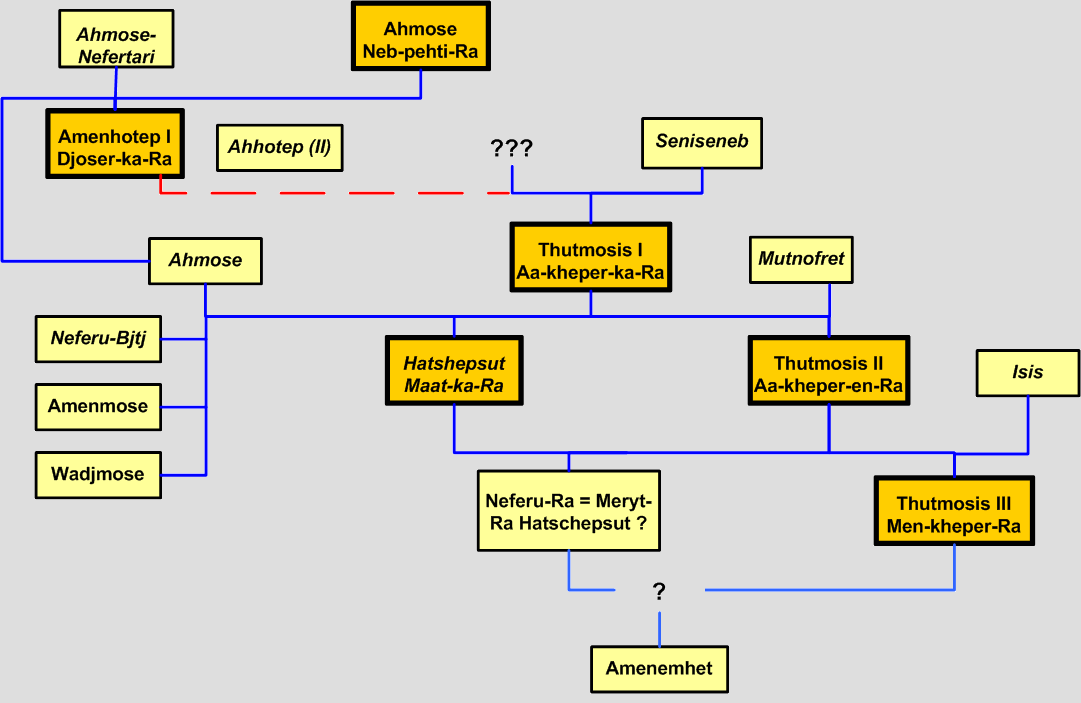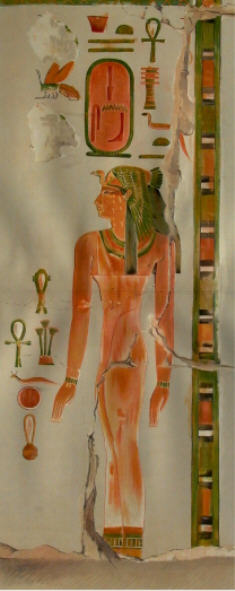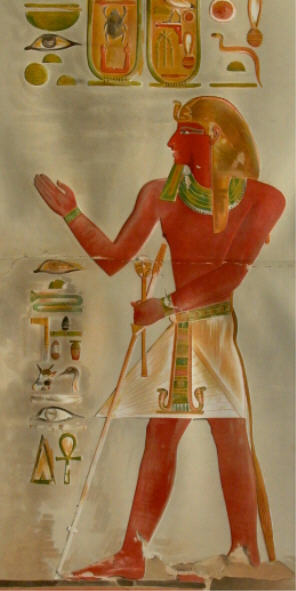|
Maat-ka-Ra Hatshepsut |
last update:
14.04.2009
|

| Possible genealogical tree of the early 18. Dynasty, the dashed
red line visualizes the results of investigations of the mtDNA by Woodward
(see below) which suggest that the unknown father of Thutmosis I was most
likely Amenhotep I. Dodson and Hilton (2004) suggest in their recently
published book "The Complete Royal Families of Ancient Egypt" that
Ahmose-Sipairi, most likely a son of Seqenenre Taa (II) was the husband of
Senisoneb and therefore the father of Thutmosis I. |
| In the genealogical tree shown above some of the connecting
lines are questionable. Already the origin of the mother of Hatshepsut, Ahmose,
is not certain (see also
below "historical review"). Some believe that she was a daughter of
Amenhotep I (= Amenophis I), others believe that she was a daughter of Ahmose
and Ahmose-Nefertari - if so, she would have been a sister of Amenhotep I. It is
also assumed that she might have been a peripheral member of the royal family and
that she had married Thutmosis I, in order to strengthen his claim to the throne.
In this connection it seems to be important that the Ahmose had held the title
"King's Sister", but never the higher-ranking title of a "King's
Daughter". Therefore, she can not have been either a daughter of Amenhotep
I or one of his father and predecessor, Ahmose. It is therefore assumed that
she only has been a (half-) sister of Thutmosis I (see below).
|
| In her biography Joyce Tyldesley (Tyldesley, J.,
"Hatshepsut - the female Pharaoh"; 1996) mentioned the possibility
that both, prince Amen-mose and prince Wadj-mose, were not the sons of Ahmose, but
those of Mut-nofret, the 2nd wife of Thutmosis I. There is not very
much known about Mut-nofret, obviously she has been a high- ranking
woman possibly of royal blood. An inscription in Karnak temple (Tyldesley,
loc. cit.) calls a Mut-nofret "King's Daughter" - but who was
the father? In the mortuary Chapel of Thutmosis I Mut-nofret appears
together with prince Wadj-mose. In this picture she is crowned with the royal
uraeus and her name is written in a royal cartouche. In any case it seems
quite clear that she was the mother of the successor Thutmosis II |
| The genealogical tree above, if one agrees with it, shows
- at least - that none of the three "Thutmosid kings" was located directly in the royal blood line.
Due to this genealogical tree Thutmosis I and II have married the
"Royal Heiress", however we do not really know whether this principle was "valid". If one
agrees with the "Royal Heiress"-theory, then a marriage between
Thutmosis III and the daughter of Hatshepsut, Nofru-Ra (= Neferu-Ra),
who have been half-brother and half-sister to each other, must have been
on the schedule. However, Nofru-Ra died most likely at an age of about
15 or 16 years, obviously before she was married with her younger half-brother. |
Historical review
About 100 years before Hatshepsut, at the end of the "2nd
intermediate period" - which should be called more correctly the "Hyksos
period" -, the Ahmosid family took the power at Waset (Thebes).
The ancestress of the Ahmosid family was Tetischeri, whose father, Tjenna, and
whose mother, Neferu, were definitely not of royal origin. Tetischeri was probably the
"Great Royal Wife" of the Senacht-en-Ra, the 1. Ahmosid ruler, and beyond that
she carried the title "King's Mother".
|
| Most likely, Senacht-en-Ra had to accept the supremacy of the
Hyksos who dominated Lower Egypt and a good portion of Upper Egypt. His successors and - probably - sons Seqen-en-Ra Tao and Kamose
started to fight against the political domination of the Hyksos. This resulted
in military campaigns in which Seqen-en-Ra Tao was killed. Kamose
himself advanced with his army already to the capital of the Hyksos, Auaris,
but could not take the town. This, however, was finally done by his successor
Ahmose I, the oldest son of the Seqen-en-Ra Tao. |
| Ahmose I conquered Lower Egypt and succeeded in driving
the Hyksos completely out of Egypt. Finally, he took their Asiatic residence,
Shahuren. Since he succeeded in the reunification of Upper and Lower
Egypt, he became the 1.ruler of the 18. Dynasty in the list of kings, although
he - as well as his successor Amenhotep I - belongs to the Ahmosid family. |
| Amenhotep I, son of Ahmose I and his "Great Royal
Wife", Ahmose-Nefertari, probably ascended to the throne, because
his oldest brother deceased prematurely. At the time of his accession Ahmose-Nefertari,
"King's Mother", was probably still alive. Amenhotep I himself had no successor, because his son Amenemhet also died in infancy.
Thus, the male line of the Ahmosids ended up with Amenhotep I - and
he, therefore, should actually be listed as the last ruler of the 17.
Dynasty. |
|
His successors was Thutmosis I. The antecedent of his mother Sen(i)seneb A
(Dodson and Ikram, 2004) -
who only carried the title "King's Mother" - is unknown, his
father is not mentioned at all.
|
|
A few years ago
Woodward (Woodward, S., The Ostracon,
12, 1, 2001) had the opportunity to examine DNA samples from several mummies. Among
others he examined the mitochondrial DNA (mtDNA) which is inherited solely from
the mother. Investigation of mtDNA-samples taken from the mummy which was said to be
that of Thutmosis I (Unknown Man; JE 26217, CG 61065) revealed that
"new" mtDNA would have been introduced with this man into the royal family -
if so this would support the assumption that the mother of Thutmosis I, Sen(i)seneb,
was non-royal.
|
| Sporadically, the assumption was expressed that Sen(i)seneb could
have belonged to a side branch of the old family of Theban rulers, the Taosids!
However, up to now no clues are supporting this. |
|
Additional investigations done by Woodward using nuclear DNA suggest that Amenhotep I may
have been the father of the man supposed to be Thutmosis I. But all these investigations have not been published yet
in a scientific paper, so there is obviously no peer review of these results. |
| The CT-scans of the mummy of the "Unknown Man"
(JE 26217, CG 61065), which were done recently by the SCA, suggested that
this man died between an age of 25 to 35 years. Furthermore, the scans revealed
a piece of metal about 2 cm large in the right thorax - probably an arrowhead. Since Thutmosis I
probably died at an age of about 50 and historical records do not indicate that
he died in a battle, the mummy of the "Unknown man" is with great certainty not
the mummy of Thutmosis I. So Woodward was using the old assumption that the mummy of Thutmosis I had been correctly identified. |
| According to Ikram and Dodson
(1998) resp. Dodson and Ikram (2004) it is also possible that the mummy of the "Unknown
Man" (JE 26217, CG 61065) is the mummy of Ahmose-Sipairi. Ahmose-Sipairi
who was probably a son of Taa II and his wife Aahotep I had also been suggested to be - perhaps - the father of Thutmosis I.
|
| The origin of the
"Great Royal Wife" of Thutmosis I, Ahmose, is unknown. Some
scholars assume that the mother of Hatshepsut was a royal princess, who
married Thutmosis I to legitimate his accession to the throne. However, the fact that
she was given only the title "King's Sister" and was never called
"King's Daughter" does not support an affiliation to the royal family.
The title "King's Sister" may point only to the fact that she possibly
has been a (half-) sister of Thutmosis I, and thus most likely, not of royal
origin.
|
| An identification of the "Great Royal Wife, King's Sister"
Ahmes with Ahmes-Nebetta (king sister, king daughter) is not plausible according
to Dodson and Hilton (2004), since the titles do not agree (see also: Gitton,
M., Les Divines Epouses de la 18e dynasty. Of Paris 1984). Ahmes-Nebetta, who is
mentioned on the partly preserved statue Louvre N496, is probably a daughter of
Taa II and Ahhotep I. |
|
If the recent mtDNA investigations of the Supreme Council of Antiquities (SCA)
really show a relationship with Ahmose Nefertari and if the identification of
the mummy from KV60 as Hatshepsut is correct then Ahmose Nefertari was the
grandmother of Hatshepsut and her mother Ahmose a sister of Amenhotep I. |
|
Ahmose (JaH-ms)
|

|
| On the other hand, at different opportunities Ahmose -
who was called on a stele of a man from Edfu as the "Great Royal
Wife beloved by King Thutmosis I." (Sethe, Urkunden IV,
31,1914) - is represented
in an outstanding position. For example, Thutmosis II and his wife Hatshepsut appear
together on a stele with her mother Ahmose - the "King's Mother",
Mut-nofret, is not shown on this stele. Furthermore, in the main
sanctuary of Djeser djeseru the deceased Ahmose is shown together with
other deceased members (Thutmosis I and II, and Neferubiti, a [half-]sister of Hatshepsut) of the family of Hatshepsut as well as with the three still living members
(Hatshepsut, Neferu-Ra, Thutmosis III) |
|
However, the emphasis of her person could also point to a connection to the royal
family, perhaps to an early lateral branch of the Ahmosids. In this connection Sethe (1932) refers to the fact that names with a reference to the God "moon (JoH)" were very
popular in the family with both sexes. To the bearers with an appropriate name
belongs e.g. Ah-hotep ("the moon is pleased"), wife of the founder of the dynasty, Ahmose, or
Ahmose-Nefertari, the mother of Amen-hotep I, Ahmose-Sat-Amun, wife Amen-hotep
I, and also "Ahmose (the moon is born)". He therefore assumes that
Ahmose likewise has been a member of the family .
A royal
origin of Ahmose might not only have contributed to the legitimacy of the accession of Thutmosis
I, but also later
to the legitimacy of the accession of Hatshepsut herself - i.e.
Hatshepsut would have had a certain claim to take the throne due to the matrilineal
blood line to the Ahmosids - at least, a more important
claim than Thutmosis III (and others!).
In connection with the origin of Ahmose it is also interesting that the
mother of Hatshepsut has never been "God's Wife of Amun".
Hatshepsut can not have gotten this title from her mother, she must have
been introduced into this office by her predecessor - probably after she
had been "adopted" by the actual "God's Wife"
(Ahmose-Nefertari).
|
Thutmosis I and the "King's Mother"
Sen(i)seneb.
E. Naville "The Temple of Deir el-Bahari",
1894-1908, Tafeln XIII and XIV |
|



